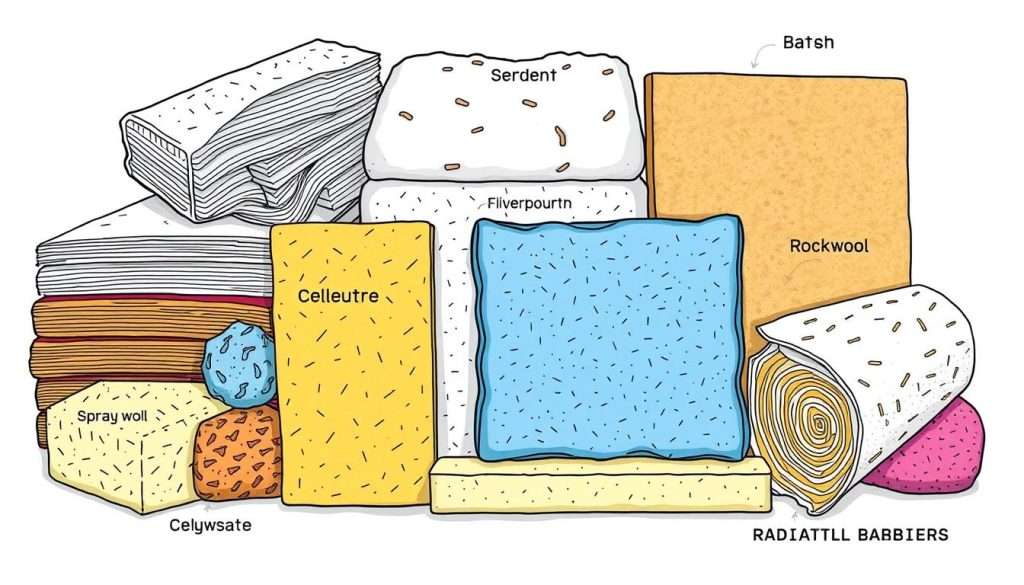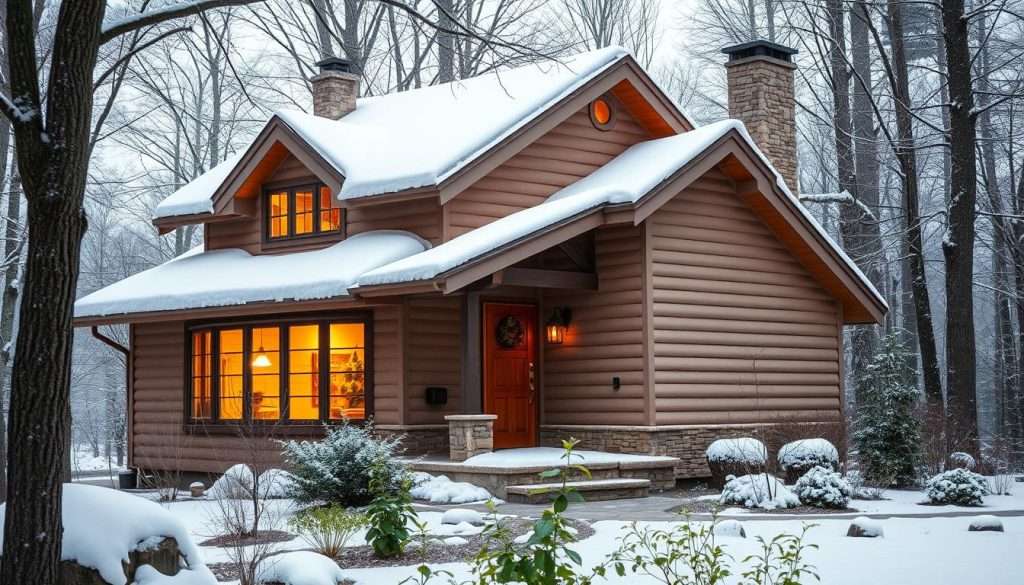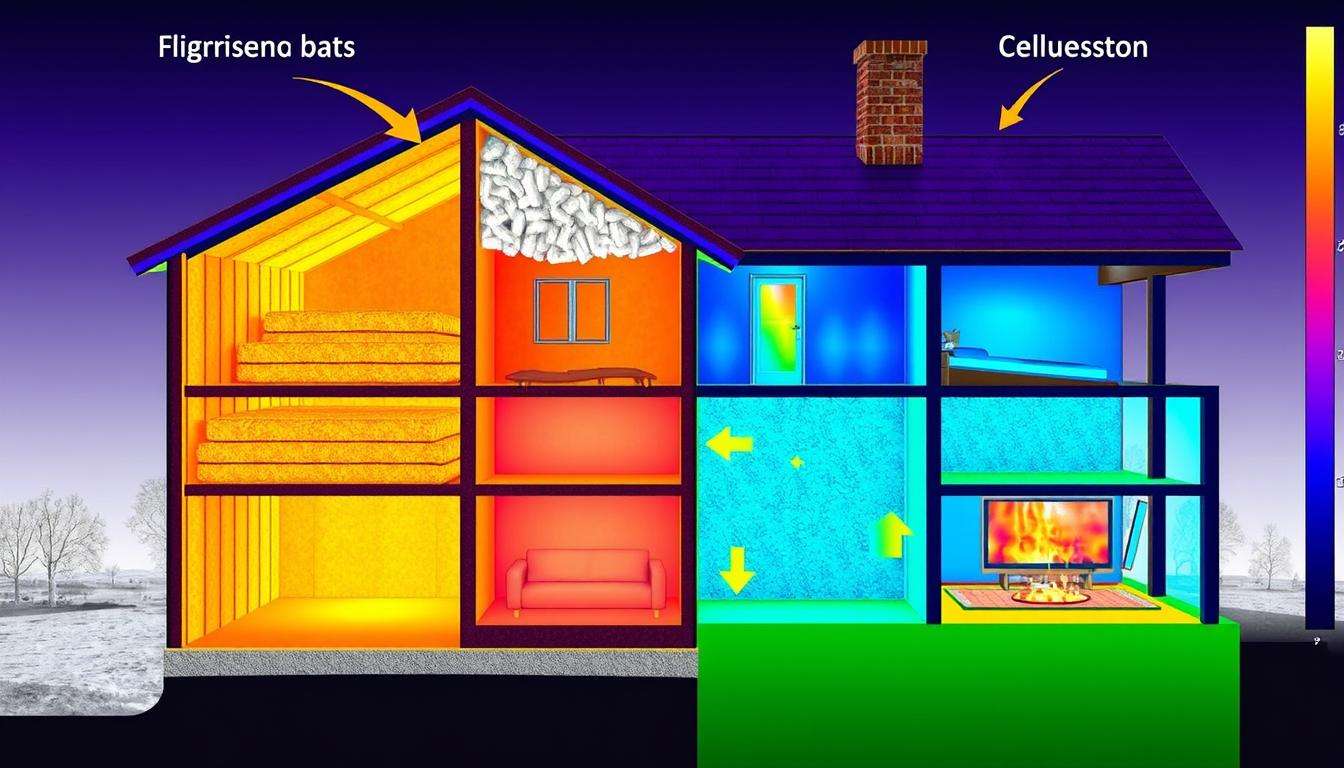Insulation is key to keeping your home comfy. It stops heat from moving in and out. This keeps your home warm in winter and cool in summer.
Heating and cooling use a lot of energy. Good insulation can save a lot of energy. You can learn more about insulation at the Energy Saver guidelines.
Insulation makes your home cozy. It works best when installed right. This guide will show you the different types of insulation and how to choose the best one for your home.
Key Takeaways
- Insulation helps reduce heating and cooling costs significantly.
- The R-value measures insulation effectiveness, with higher values indicating better performance.
- Improperly installed insulation can lead to thermal bridging, diminishing its effectiveness.
- Various insulation materials, like fiberglass or cellulose, cater to different needs and budgets.
- Proper insulation can enhance comfort and potentially increase your home’s resale value.
What is Insulation?
Insulation is key in your home. It keeps the temperature right and saves energy. We’ll look at what it is, why it’s important, and what it’s made of.
Definition of Insulation
Insulation stops heat from moving around. It keeps your home warm in winter and cool in summer. It works by trapping air to keep heat in or out.
Purpose of Insulation
Insulation keeps your home at a steady temperature. This makes it more comfortable and saves money on energy. It also helps block out sounds and keeps moisture away from your home.
Common Insulation Materials
There are many insulation materials, each with its own benefits and drawbacks. Here are some common ones:
- Fiberglass: It’s affordable and stops heat well. You can find it in batts or rolls.
- Cellulose: It’s mostly recycled paper. It’s good for the planet and can be blown into place.
- Foam Board: These are solid panels. They work well for walls and ceilings.
- Spray Foam: It creates a tight seal. It’s great for keeping heat out or in, depending on what you need.
How Insulation Prevents Heat Transfer
Insulation keeps your home comfy by stopping heat from moving around. It works by blocking three ways heat can move: conduction, convection, and radiation. This makes your home more energy-efficient and cozy.
Conduction
Conduction happens when heat touches something directly. Stuff like fiberglass batt and spray foam block this heat. For example, fiberglass batts can have an R-value of R-3.14 to R-4.3 per inch.
A 3 ½-inch thick fiberglass batt can reach an R-value of about R-13. But, it’s key to install it right. A 4% gap in insulation can cut its effectiveness by 50%.
Convection
Convection is when heat moves through air. Bad insulation lets warm air out and cold air in. This hurts your energy use.
Good insulation seals these gaps. It keeps your home’s air still, keeping temperatures steady.
Radiation
Radiation is heat moving through waves. Radiant barriers reflect heat, making your home more energy-efficient. They’re especially useful in attics and roofs, where heat can sneak in.
Also, dealing with thermal bridging in places like steel studs helps save energy. By controlling these heat transfers, you can make your home more comfortable and save on energy.
Types of Insulation Materials
Knowing about insulation types is key for homeowners. It helps improve energy use and comfort. Let’s look at fiberglass, foam board, and cellulose insulation.
Fiberglass Insulation
Fiberglass insulation is very common. It comes in batts or loose-fill. It has high R-values, showing how well it insulates.
For example, medium-density fiberglass batts can reach R-15 in 2 by 4-inch walls. Higher options can go up to R-30 in 8.5-inch spaces. But, it needs careful installation to work well.
For more info, check out this guide.
Foam Board Insulation
Foam board insulation is made of rigid panels. It’s great for walls, roofs, and foundations. It can have high R-values and fight moisture well.
This makes foam board good for many places. It helps keep energy use low in different homes.
Cellulose Insulation
Cellulose insulation is eco-friendly. It’s mostly recycled paper. It’s good for the planet and keeps things warm or cool well.
It’s blown into spaces to fill them evenly. This stops air leaks. It also has borate to protect against fire and bugs.

R-Value Explained
Understanding R-value is key to making your home cozy. It shows how well insulation stops heat from moving. The higher the R-value, the better the insulation works. Let’s explore what R-value means, why it matters, and how to pick the right one for your home.
What is R-Value?
R-value shows how well insulation keeps heat from moving. It changes based on the insulation’s type, thickness, and material. The higher the R-value, the more energy-efficient it is. This is important for keeping your home comfortable and saving money.
Importance of R-Value in Insulation
R-value helps figure out how much insulation you need. It depends on your local weather and building rules. You can use R-value charts to find out how much insulation your attic, walls, and crawlspaces need.
Using the right R-value can cut down on your heating and cooling bills. This makes your home more energy-efficient.
How to Choose the Right R-Value
Choosing the right R-value involves a few things:
- Look at your local weather: Different areas need different R-values.
- Know where you’re insulating: Attics, walls, and basements might need different levels.
- Think about your heating and cooling systems: This helps decide on the right insulation cost and efficiency.
For example, spray foam can have an R-value of up to 6.5 per inch. This makes it great for keeping your home warm while keeping costs down.
| Insulation Type | R-Value per Inch | Best Uses |
|---|---|---|
| Rigid Foam | Up to 5.0 | Walls, foundations |
| Spray Foam | Up to 6.5 | Attics, walls, crawlspaces |
| Fiberglass Batt | Up to 3.8 | Standard wall insulation |
| Blown-in Cellulose | Up to 3.8 | Attics, walls |
By following these tips, you can keep your home cozy. You’ll also use less energy and save on insulation costs.
Where to Use Insulation
Knowing where to insulate in your home is key. It makes your home more energy-efficient and comfy. We’ll look at important spots for insulation.
Attics and Roofs
Attics and roofs lose a lot of energy. Adding insulation here cuts down on heating and cooling costs. Make sure to put insulation on the attic floor, not the roof. This keeps your home warm in winter.
Walls and Floors
Insulating walls stops cold spots. It keeps your home cozy. Don’t forget the floors, especially if they’re over garages or crawl spaces. Insulating both walls and floors saves a lot of energy.
Basements and Crawl Spaces
Basements and crawl spaces need insulation too. It keeps moisture out and makes your home more comfortable. Insulating these areas keeps your home warm and cozy.
Benefits of Insulation
Insulation does more than just save energy. It makes your home or office better in many ways. It’s a smart choice for anyone who wants a better place to live or work.
Energy Efficiency
Insulation helps you save money on energy. It can cut your heating and cooling costs by up to 45%. This is because it keeps your home at a steady temperature.
Your heating and cooling systems won’t work as much. This means they last longer and cost less to run.
Noise Reduction
Insulation also makes your space quieter. It blocks sound, making your home or office more peaceful. This is great for city dwellers and those who work from home.
With better sound insulation, you can focus better. Your living space will feel more enjoyable and productive.
Moisture Control
Insulation also controls moisture. It stops moisture from building up, which can cause mold and damage. This keeps your air clean and your home safe.
This is very important in damp places like basements. Moisture can hide and cause problems.

Common Insulation Issues
Knowing about insulation problems can make your home more comfortable and energy-efficient. Issues like settling, moisture damage, and pests can happen. Spotting these problems early helps you fix them fast.
Settling and Compression
Insulation can settle or compress, making it less effective. This can cause gaps, letting heat pass through. To avoid this, it’s important to install insulation correctly. This keeps it working well for a long time.
Moisture Damage
Moisture is bad for insulation. If it gets wet, it loses its ability to keep your home warm. Mold colonies can grow fast when insulation gets damp. So, it’s key to control humidity and fix leaks to keep your insulation in good shape.
Pest Infestations
Some insulation can attract pests if it’s not sealed well. Old homes with wool insulation are at risk because pests like cozy spots. Checking for pests often helps catch problems early. This keeps your insulation working right and your home safe.
DIY Insulation Installation Tips
Starting a DIY insulation project can seem tough. But, with the right steps, it can be fun and rewarding. First, learn about safety, get your tools and materials ready, and follow a guide.
Safety Precautions
When working with insulation, safety first. Wear protective gear like:
- Dust mask
- Gloves
- Safety glasses
- Long sleeves
This gear helps avoid irritation and breathing problems. Make sure the area is well-ventilated to avoid dust.
Tools and Materials Needed
For a good insulation job, you’ll need:
- Utility knife
- Tape measure
- Cordless staple gun or hammer tacker
- Insulation hangers
- Fiberglass, cellulose, or mineral wool insulation
Have enough insulation and pick the right type for your space. The R-value matters.
Step-by-Step Installation Guide
Here’s how to do it right:
- Check the area and figure out how much insulation you need.
- Measure and cut the insulation to fit perfectly, without squishing it.
- Put the insulation in carefully, making sure it fills the space well and doesn’t leave gaps.
- Seal any air leaks around the insulation with caulking or spray foam.
- In the attic, use two layers, with the first facing down towards the drywall to block moisture.
- Keep insulation 3 inches away from heat sources to stay safe.
Be careful with every step. Even small gaps can hurt your insulation’s performance.
By following these tips, you can make your home more energy-efficient and cozy.
When to Hire a Professional Insulation Contractor
Knowing when to get help with insulation is key. You might need a pro if you’re not sure what insulation to choose. Or if your project is big or if you have moisture issues.
Signs like drafts or temperature changes mean you might need help. Since most buyers want energy-efficient homes, fixing insulation can save money.
Signs You Need Professional Help
High energy bills might mean your home needs better insulation. Getting a pro to check your home during renovations is smart. They know how to handle different insulation types.
For homes built before 1978, checking for lead paint is a must before starting insulation work.
Choosing the Right Contractor
Finding the right insulation contractor takes some work. Look up their background and read reviews to see if they’re good. Make sure they have the right licenses and certifications.
It’s also important to know what warranty they offer. This covers both the materials and the work. Get quotes from a few contractors to compare prices and make a smart choice.
Cost-Effectiveness of Professional Installation
While doing it yourself might seem easy, hiring pros is better. They do the job right and fast, making your home more energy-efficient. They save you time and prevent costly errors.
Many places offer discounts for insulation work. So, hiring a pro can save you money in the long run.
